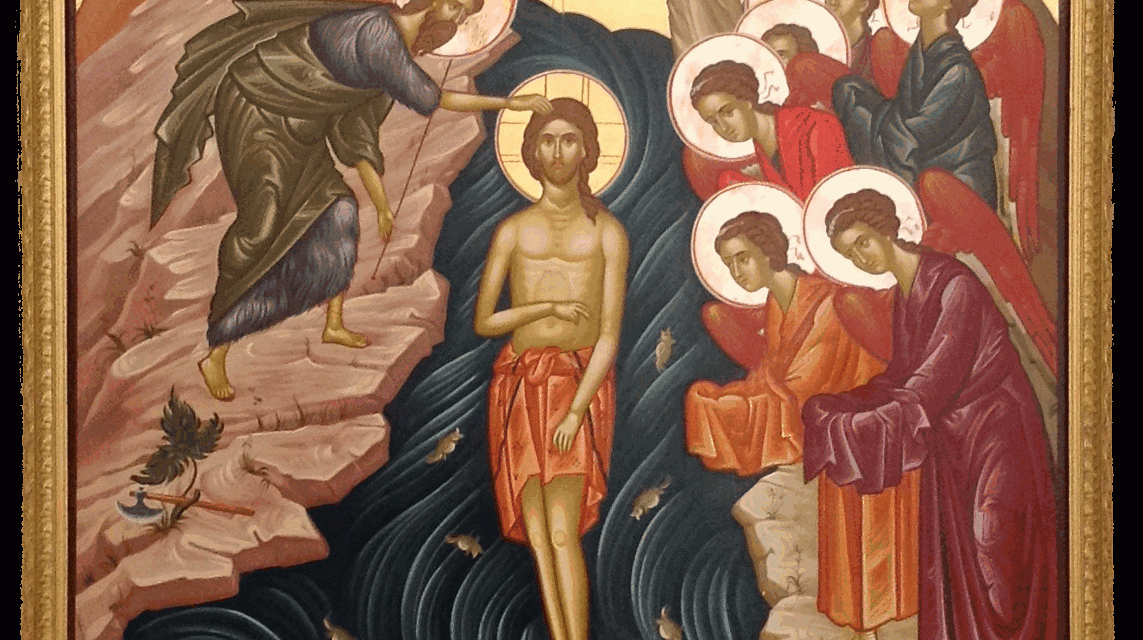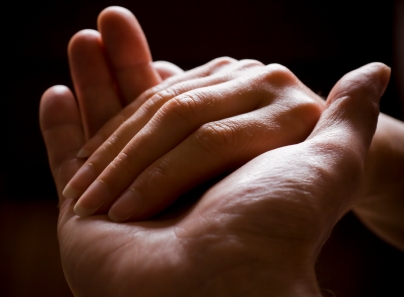image courtesy of ShareAlike 4.0 International (CreativeCommons)
The readings for this Sunday may be found on the USCCB website:
- Isaiah 42:1–4, 6–7
- Psalm 29:1–4, 9–10
- Acts 10:34–38
- Luke 3:15–16, 21–22
Since my local parish church building is old and relatively small, our cry room doubles as the baptistry, and so kids and adults who find themselves there during liturgy must navigate a large baptismal font, situated not too far from the center of the room. It looks like a giant-sized chalice, and is made entirely from metal, so that it produces a sound similar in volume and timbre to a steeple bell when one strikes it with a toy or a book. A cloth with an embroidered cross at its center usually covers the top, and sometimes there are still beeswax tapers in the candleholders set just above the rim. A few months ago, I was in this room during Sunday Divine Liturgy, watching my youngest daughter roam about, trying to find something that interested her. She stopped near the font, resting her gaze upon it, and I dutifully prepared to intervene in case she decided to try to “ring” it. But instead, she just pointed at it and turned to me and said something like “that’s where they dipped baby Agnes in the water when she was naked.” “Yes,” I softy replied, “and that’s where you were dipped you too, when you were a baby.” My daughter’s eyes glazed over for a moment, but then she smiled and said, “Nooo, Daddy; I wasn’t dipped in there!” “Yes you were,” I insisted, “and that’s when you became God’s child; that’s when you were baptized.”
I’ll be honest; having a large, empty metal baptismal font in the shape of a giant chalice in the cry room can sometimes be a nuisance. But in this instance, it occasioned a moment of grace: however hazily or skeptically, my daughter was able to link the baptism she witnessed there with the one she herself experienced. Whatever mysterious, solemn, and festive occasion required the little baby she saw to be dipped naked into this giant cup, anointed all over with scented oil, and then clothed with a long, beautiful white robe—this happened to her too! And to her siblings as well, it turns out! My daughter is still too young for concepts like “the remission of original and temporal sin” to mean much, let alone the more foundational principles of “sacramental efficacy” or “divine filiation.” But the special quality of the action itself seems firmly impressed upon her memory, and I think it meant something for her to discover that she herself took part in it, as did all her immediate family members.
As she grows older, my daughter will be able to take in more fully the significance of Jesus’ baptism, the place of baptism in the sacramental economy, and why Jesus would command his apostles to “make disciples of all nations, baptizing them in the name of the Father, and of the Son, and of the Holy Spirit” (Mt. 28:19). But for now, it is enough that she sees baptism as something “special” the Church does for babies, and that it was done for her as well. And that’s not at all a bad foundation upon which to build. Like so much else the Church does, baptism is something particular (peculiar?) that somehow brings everyone together into a common life of friendship with God and with one other. The Lord calls each of us by name, and immerses us in His grace through the mediation of His Body, the Church.
The first reading for this feast comes from the prophet Isaiah, through whom the Lord speaks words that will echo from the heavens after Jesus’ baptism:
“Here is my servant whom I uphold, my chosen one with whom I am pleased, upon whom I have put my spirit; he shall bring forth justice to the nations.”
Isaiah 42:1-2
After John baptizes Jesus, the heavens open and the Holy Spirit descends upon Jesus “in bodily form like a dove,” and a voice from heaven proclaims “You are my beloved Son; with you I am well pleased” (Lk. 3:21-22). The Eastern Catholic tradition emphasizes the Trinitarian character of this event, referring to it as “the Theophany” (the manifestation of God), since the revelation of Jesus’ identity comes only in and through the revelation of His relationship to the Father and the Holy Spirit. This same voice from heaven repeats this message almost verbatim later in Jesus’ life, when Moses and Elijah appear alongside the transfigured Christ on Mt. Tabor. In both instances, God the Father attempts to communicate a simple yet essential message about the identity and mission of Jesus: “This is my beloved Son.” So much is packed into that message; so much may be drawn out from it. But at its heart, it conveys a message of paternal delight and filial intimacy: “this One here is my Beloved.”
We hear in this message only a fading echo of Isaiah’s prophecy, which goes on to speak of how “my chosen with whom I am pleased” will bring about “the victory of justice” in the world, but even there the dominant note is one of meekness and tender concern. This chosen servant will “bring forth justice to the nations,” but he will not break a bruised reed or quench a smoldering wick as He does so. And what is more, God’s people are called not simply to stand back and watch, but to take part in this “victory of justice:”
“I, the Lord, have called you for the victory of justice, I have grasped you by the hand; I formed you, and set you as a covenant of the people, a light for the nations, to open the eyes of the blind, to bring out prisoners from confinement, and from the dungeon, those who live in darkness.”
Isaiah 42:6-7
Is the Lord talking here merely to “the chosen servant” or to all of Israel? The Catholic tradition has always maintained that it is not only possible but appropriate to leave room for both interpretations. Quite understandably, Christians regard Christ as the one about whom the Lord says through Isaiah “Here is my servant… my chosen on with whom I am pleased.” We hear their echo at the Baptism, after all. Yet at the same time, Christians may also hear these words as addressed to God’s people, and even to themselves as individual members of that people.
Herein lies what I find to be the deepest mystery at the heart of baptism, and indeed at the heart of the whole sacramental order: there are certain actions Christ performed that, when performed by us within the context of His Body the Church, allow us to share in His very nature and mission in the world. In other words, Jesus did not come into the world merely to do things for us, but rather he came to open up through his humanity a way to participate in Him, to graft ourselves into His very life. Obviously Jesus himself doesn’t need baptism to wash away his own sins, nor does it seem strictly necessary for Him to redeem the world through His death. So what exactly is “fulfilled” by Jesus’ baptism? In what way would His mission remain incomplete without it?
The little exchange I had with my daughter in the cry room afforded me a new glimpse into what “participation in Christ” might mean, particularly with respect to baptism. I have heard many times that baptism transforms us into “little Christs,” and intellectually I completely affirm the strong notion of divine filiation that entails. Yet to begin where we are is to begin as a child, and the first recognition of the child is always the presence of others, and the love offered by them. Even at 4 years old, my daughter knew that one of central meanings of baptism is “you are special.” And when I told her about her own baptism in that very font, she knew that the same meaning applied to her as well, and to all her brothers and sisters (and even her parents!). My prayer is that one day she will discover with joy the chain of love receding into the hazy mists of time that connects her baptism to the one upon which hers was founded, so that she might remember with ever greater certitude that the heavenly voice that spoke “my Beloved” that day was referring no less to her than to Christ, just as it applies in equal measure to all those who have been incorporated into Him “through the bath of rebirth.”



